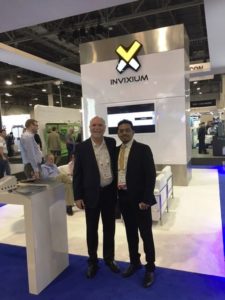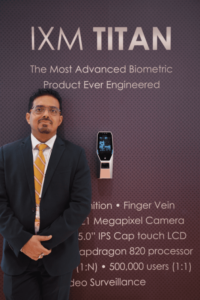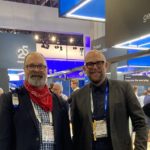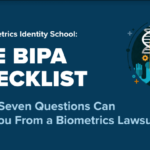
FindBiometrics is in Las Vegas this week reporting live from ISC West. The exhibition hall opens tomorrow, April 10, and Canadian biometrics company Invixium will be exhibiting from booth 22109, showcasing its advanced multimodal identity and access solutions at the biggest converged security expo in the United States.
Prior to the show, FindBiometrics President Peter O’Neill sat down for an interview with Shiraz Kapadia, President & CEO, Invixium. Their in-depth conversation starts with a preview of what to expect from Invixium at ISC West, and goes on to detail how the company’s innovative solutions are addressing current challenges in the physical access and enterprise biometrics markets. Kapadia speaks about the healthcare market too, and highlights why the higher education market shows so much promise for biometrics, before concluding with his predictions for the industry’s future.
Read the full Findbiometrics interview with Shiraz Kapadia, President & CEO, Invixium:
Peter O’Neill, President, FindBiometrics: We are heading to one of my favorite conferences in the world, the ISC West Show, and we are seeing so many changes there with physical and logical access coming together in every enterprise around the world. We are seeing lots of biometrics there too and it is a very exciting show for us and I’m sure for you too. What will you be highlighting at this year’s show?

Shiraz Kapadia, President & CEO, Invixium: You’re absolutely right, Peter. Fortunately, there are a lot of positive changes going on in the market where biometrics is increasingly coming to the forefront at a very rapid pace. We started the company in 2012 with the sole purpose of creating a product portfolio that is modern, good looking, and easy to use. As much as possible, we tried to develop a unique offering in an already crowded market. Like the smartphone industry, there are so many mobile phones brands such as Apple, Samsung, etc., so many different kinds but they are unique in their own way. There are usually very subtle things that make them unique and we tried to do the same thing with our product line.
Our latest release is a multi-biometric product called IXM TITAN, capable of face recognition as a primary authentication method along with fingerprint or finger vein as a secondary. To make the product look good, to make the product appealing, to make it functional, to make it powerful; it was grueling but exciting to come up with this product! That is what we concentrated on last year. Based on the reaction from the market, it was very rewarding for us that the products that we developed are resonating so well with the global marketplace including North America. We just started penetrating North America not too long ago and the response has been fantastic.
We are returning to ISC West, which is a very exciting show for us, with our full product portfolio. We have five different product lines: IXM MYCRO, IXM MERGE, IXM TOUCH 2, IXM SENSE 2, and the final one which we call ‘The Most Advanced Biometric Product Ever Engineered’, the IXM TITAN.
After some analysis, we have identified that there is a vacuum in the market. If you look at the access control market as a big pie, there is a slice of the pie that represents the biometric access control portion. There are so many companies that are trying to get market share within the same slice of pie but there is a much larger slice where biometrics has traditionally not worked: harsh, rugged, salty, wet, chemical or manufacturing environments. TITAN was specifically designed for these types of environments and we have put in the best technology, the best components, the best sensors, and the best biometrics into its development. And recent indicators are proving that TITAN is working beautifully in the rugged environments where deployed.
FindBiometrics was kind enough to publish some of our videos which show how TITAN is performing in applications and environments where biometrics hasn’t worked before. We definitely will be showing that aspect at ISC West and in addition, we are developing a software to complement our hardware product portfolio which will be primarily for time and attendance leading into workforce management.
There are product manufacturers, there are time and attendance software manufacturers, there are access control software manufacturers, but what we are attempting to do is give the market a one-stop-shop solution. It is our product, we are capturing the data and now we are offering a software solution which will do access control at the basic level but time and attendance and workforce management at the enterprise level. We are embarking on an evolution as a biometric solution manufacturer; no longer just a product manufacturer, and we are very excited to be showing that aspect of Invixium at ISC West this year.
FindBiometrics: I look forward to coming by and seeing these new products. Can you tell us if this past year has been a good year for your company and please tell us about some of the highlights?

Invixium: The past year has been very exciting and very good for Invixium. We are a relatively new company and the time around ISC West is always very exciting as it coincides with our anniversary. We have completed 7 years as a business and that feels really good. From a product perspective it has been fun to see, in addition to all the products increasing in sales, volumes and revenues, TITAN going out into the market and being deployed in real projects rather than POCs. We have seen many projects where TITAN has helped businesses modernize their access control infrastructure and employee tracking. We have also seen many projects where TITAN is directly replacing antiquated, bulky, ugly and much less powerful biometric solutions in high security environments.
On the market growth side, the Middle East continues to be our largest market, since it was the first market that we focused on, which continues to grow in the high double digits. The response that we are experiencing in North America is absolutely fantastic given that we just started about 18 months ago. Fortunately, we are trying to do all the right things and it is bearing fruit. We also started our penetration in Africa around the same time and that is going really well for us too.
We are incredibly excited about some key partnerships that have developed and strengthened over the past year. As part of our strategy, we have completed integrations with most of the top manufacturers in access control like Genetec, Honeywell, Schneider Electric, Feenics, Lenel S2, RS2 Technologies, Galaxy Control Systems, Paxton, Gallagher, and some have signed on as Distribution Partners who are reselling our product, thus very excited to grow those partnerships over the next couple of months.
If our strategy works out and we continue to do the right things, we look forward to high double-digit growth for 2019.
FindBiometrics: There are a lot of drivers or trends that are pushing our industry, you mentioned a couple of them, but what do you see as the key ones? What excites you most about industry trends that are pushing our industry?
Invixium: First and foremost, I see a massive adoption of biometrics regardless of what modality across many verticals like: payments, mobile phones and fintech. It is now being perceived, even by veterans in the industry, that biometrics are becoming the de facto authentication mechanism for human beings. It is finally happening, you see it everywhere. So that is definitely one visible trend across various industries.
Breaking down into the modalities, I think the non-intrusive, non-invasive biometrics such as facial recognition are gaining tremendous traction as compared to other biometrics due to a convenience and user adoption perspective, which is exciting for me. Although there is growth in fingerprints, finger vein and iris for high security areas, I think face is the most visible biometric which is seeing tremendous growth.
In terms of consolidation which you touched on in your very first question, we have all been waiting for it, but we are maybe a couple of steps closer in terms of consolidation of physical access and logical access. I don’t think it is there yet, but we are definitely a couple of steps closer.
Another trend that I have observed and had direct experience in, is that biometrics is still a little scarce in the environments that I think need biometrics the most. For example, the harsh environments that I referred to earlier, like construction sites, the mining industry or manufacturing plants. Traditional biometrics haven’t been effective in these markets, but I think it is needed the most because that is where the workforce is and biometrics can help organizations manage and track their workforce in an automated/digital way. As technologies are maturing and becoming more ruggedized, and if it is part of the right product, I see increased adoption of biometrics being used in places where it has not been used before, namely these harsh and rugged environments.
Finally, I don’t think it is an industry consolidation, but there are more and more solutions providers that we will see in the market where the entire solution is coming from one company rather than integrators having to take different technologies from different places. I’m seeing that trend as well where there are companies offering full-fledged solutions to integrators which is making everybody’s life easier: the installer’s, the end user’s, as well as the manufacturer’s.
FindBiometrics: As you were describing this harsh environment type of scenario my mind shifted to the healthcare area where although it is not dirt and harsh environmental areas it has its own harshness. Do you see that as a vertical market that is ripe for picking?
Invixium: I don’t see it as being completely ripe when it comes to healthcare. There are definitely many use cases for biometrics in healthcare like: access control for restricted areas, time tracking for the workforce, logical access for systems but this is a very regulated sector and rightly so. There is a lot of scrutiny before any technology can penetrate this market. But you are right, it’s an area where security and accuracy is so critical. But with sanitization requirements, fingerprint is probably not ideal because the staff are required to wear gloves, vein pattern – same issues; face is probably the most optimal but there could be the requirement of wearing masks. So, it is just a very difficult market to penetrate but with the pace that biometric technology is maturing, I think it will come.
The market that is becoming very ripe for picking is the higher education market. There is no doubt that colleges and universities require security, but convenience also plays a big role as students, educators and academics live and work in a fast-paced environment where time is precise, so fast throughput is very much a requirement. Hence, the growth potential for the higher ed market is wide open as these challenges get resolved, and I now see that the technology is ready and optimal to address this market.
The purpose of highlighting that market is from direct experience. We weren’t strategically focused on it but when TITAN was released, we started to see the higher education market pulling TITAN because it provides the convenience, it has a sleek design, it has a multi-biometric option; where some people can use their fingerprint or finger vein but they can also use face and it provides fast throughput. TITAN can authenticate 15-18 faces per minute even through a turnstile gate and is an ideal product for time tracking applications. So, a great deal of our focus is going to be on the higher education market in the coming year.
FindBiometrics: That is very interesting and also very timely given the news that has been in the mainstream press. They have a lot of challenges in that marketplace and a lot of fraud occurring, so I think there are a number of drivers for the education market.
As our industry continues to evolve quite rapidly as you mentioned earlier, what are some of the challenges that you see for us on the horizon?
Invixium: That is a very good question. First, biometrics have been around for such a long time and adoption has been much slower than what we would have all liked. I’m sure you would agree because both of us have been doing this for over 18 years now. For any industry to flourish, what is definitely required is the right level of funding and support from the investment community to breed new entrepreneurs and to provide growth capital to those companies that want to grow. Of course, organic growth is entirely possible but the one challenge that our industry is going to be facing is to have access to the type of capital that exists in the SaaS industries or others where the capital is quite lucrative. So, I see that being a challenge as I’m not seeing that many entrepreneurs coming out with great ideas and great companies and a fundamental reason I believe, has to be the lack of capital.
Second, as biometrics is everywhere, attention will be needed to focus on making one or two applications right as opposed to trying to do everything. If companies are trying to focus on logical access, physical access and fintech along with other things, that in my opinion is a recipe for disaster. Whenever a technology is being adopted in different verticals, I encourage fellow businesses to focus on a few things and make those few things right and let others concentrate on other verticals or whatever they are good at. I wouldn’t necessarily call it a ‘challenge’, but it should be something that businesses and companies in this market are aware of.
This consolidation that we talked about in logical access, in physical access, fintech and mobile; and to be able to standardize all of these use cases to achieve full integration is going to be a pretty interesting challenge to watch out for.
FindBiometrics: Those are very wise comments, Shiraz, and it is always a pleasure to speak with someone with your wealth of experience in our industry. I really look forward to seeing you in Las Vegas at the ISC West show and congratulations on a great year. And just as an aside, I’ve seen a lot of products in the marketplace, but the design aspect of your products is truly incredible. They are such a pleasure to look at, it makes people want to use them. So, congratulations on that as well.
Invixium: Thank you very much Peter and always a pleasure to speak to a veteran like yourself.



![ID Talk at ISC West 2022: Hear the Identity Experts at Security’s Biggest Show [UPDATED]](https://idtechwire.com/wp-content/uploads/ISC-West-2022-Crowd-150x150.jpg)




Follow Us